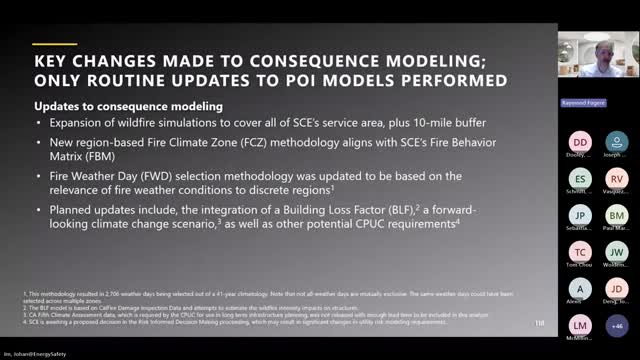SCE expands wildfire modeling to enhance risk assessment across service territory
May 24, 2025 | Office of Energy Infrastructure Safety, Other State Agencies, Executive, California
This article was created by AI summarizing key points discussed. AI makes mistakes, so for full details and context, please refer to the video of the full meeting. Please report any errors so we can fix them. Report an error »

The Office of Energy Infrastructure Safety in California held a workshop on May 24, 2025, to discuss updates to the 2026-2028 Base Wildfire Mitigation Plan. The meeting focused on significant changes in wildfire modeling and mitigation strategies aimed at enhancing safety and preparedness in the face of increasing wildfire risks.
One of the key updates presented was the expansion of wildfire simulations to cover the entire service territory of the utility, rather than just the High Fire Risk Areas (HFRA) with a buffer. This change allows for a more comprehensive understanding of wildfire risks, including areas previously overlooked. The modeling now includes a 10-mile buffer around non-HFRA regions, ensuring that all potential fire risks are accounted for.
Additionally, the workshop introduced a new region-based fire climate zone methodology. This approach segments the service area into specific zones, allowing for a more accurate assessment of localized fire risks. By analyzing weather conditions specific to each zone, the utility aims to improve the accuracy of its consequence modeling. This change is crucial, as different areas can experience vastly different weather patterns, which can significantly impact fire behavior.
The integration of building loss factors into the modeling was also highlighted. This update aims to refine the understanding of the consequences of wildfires on structures, distinguishing between damaged and completely lost buildings. The utility plans to utilize CAL FIRE damage inspection data to enhance this aspect of their modeling.
Looking ahead, the workshop emphasized the importance of adapting to forward-looking climate change scenarios. The utility aims to proactively address potential future risks rather than reactively responding to past events. This includes staying updated on regulatory changes, such as the potential shift to a 24-hour modeling approach, which the utility is prepared to implement if necessary.
In conclusion, the workshop underscored the utility's commitment to improving wildfire mitigation strategies through enhanced modeling and localized risk assessments. These updates are expected to lead to more effective mitigation measures, ultimately aiming to reduce the impact of wildfires on communities and infrastructure across California and beyond.
One of the key updates presented was the expansion of wildfire simulations to cover the entire service territory of the utility, rather than just the High Fire Risk Areas (HFRA) with a buffer. This change allows for a more comprehensive understanding of wildfire risks, including areas previously overlooked. The modeling now includes a 10-mile buffer around non-HFRA regions, ensuring that all potential fire risks are accounted for.
Additionally, the workshop introduced a new region-based fire climate zone methodology. This approach segments the service area into specific zones, allowing for a more accurate assessment of localized fire risks. By analyzing weather conditions specific to each zone, the utility aims to improve the accuracy of its consequence modeling. This change is crucial, as different areas can experience vastly different weather patterns, which can significantly impact fire behavior.
The integration of building loss factors into the modeling was also highlighted. This update aims to refine the understanding of the consequences of wildfires on structures, distinguishing between damaged and completely lost buildings. The utility plans to utilize CAL FIRE damage inspection data to enhance this aspect of their modeling.
Looking ahead, the workshop emphasized the importance of adapting to forward-looking climate change scenarios. The utility aims to proactively address potential future risks rather than reactively responding to past events. This includes staying updated on regulatory changes, such as the potential shift to a 24-hour modeling approach, which the utility is prepared to implement if necessary.
In conclusion, the workshop underscored the utility's commitment to improving wildfire mitigation strategies through enhanced modeling and localized risk assessments. These updates are expected to lead to more effective mitigation measures, ultimately aiming to reduce the impact of wildfires on communities and infrastructure across California and beyond.
View full meeting
This article is based on a recent meeting—watch the full video and explore the complete transcript for deeper insights into the discussion.
View full meeting
